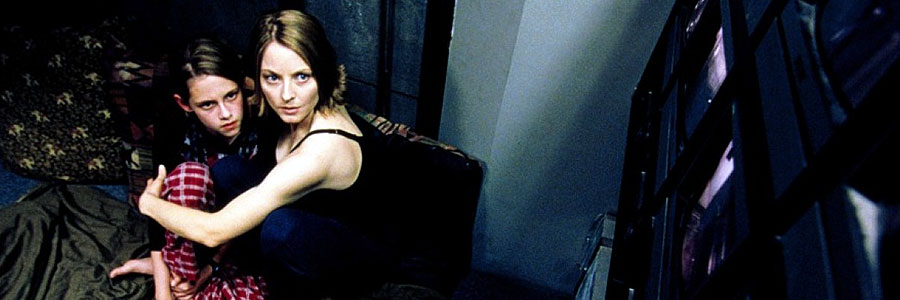
Panic Room

PANIC ROOM (MOVIE)
Columbia Pictures
Original release: March 29th, 2002
Running time: 121 minutes
Director: David Fincher
Writer: David Koepp
Composer: Howard Shore
Cast: Jodie Foster, Kristen Stewart, Forest Whitaker, Jared Leto, Dwight Yoakam, Patrick Bauchau
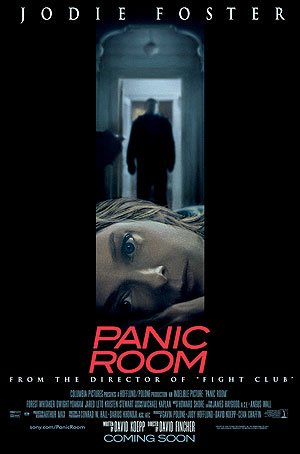
There are certain situations I’m unable to cope with and I know them only too well now to know I should avoid them at all costs. A raised voice, that unmistakable tension in the air, a look I might catch out of the corner of my eye; they all warn me that violence is near and I should do everything to get out. It comes from seeing it in my childhood and experiencing it as a teenager, it comes from waking up at night gasping for air and covered in sweat and from years spent trying to run away from my memories of it, hoping to never encountering it again. Yet I stand there frozen, feeling as if I’m choking and growing ever more nauseous, dizzy, numb and with alarm bells ringing in my head. That’s my panic and when it happens I’ve never been able to escape it because how do you run from what you carry inside of you?
But going back to external terrors rather than internal ones, when there’s an intruder in your home, the panic must be unimaginable. If you’re unable to get out it might be wise to have somewhere else inside you can get to where your intruders can’t get to you, at least until help arrives. This is loosely the premise of David Fincher’s tension-filled thriller Panic Room.
It’s in this story we meet a newly divorced mother, Meg (Jodie Foster) and her 11-year-old diabetic daughter Sarah (Kristen Stewart). The pair, after searching for some time for the right apartment, decide on a four-story brownstone on the Upper West Side of New York City which was previously owned by a reclusive millionaire who thought it would be a good idea to install a state-of-the-art “panic room” in case of such a home intrusion. The room comes complete with concrete and steel on all sides, a thick steel door, a security system with multiple surveillance cameras and a separate phone line.
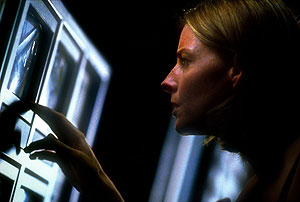
The mother and daughter, who are still trying to adjust to life without a man about the house, barely have any time to settle in before Junior (Jared Leto), Burnham (Forest Whitaker) and Raoul (Dwight Yoakam) break in on their first night there. With a plan to steal the $3 million in bearer bonds locked in a safe inside the panic room it shouldn’t be too hard, but after discovering the house is now occupied their next problem is that Meg and Sarah have heard them downstairs and locked themselves inside the very room they want to get into.
The tensions builds steadily toward breaking point in Panic Room as the trio try everything to draw the pair out including pumping propane gas into the room’s air vents, but quick-thinking Meg outwits them. Unfortunately for her the phone line inside the panic room hasn’t been connected yet and to make matters worse Sarah needs her emergency Glucagon syringe which is outside. As she suffers a seizure Meg has no choice but to venture back out which gives the intruders a chance to get in while her daughter’s still in there, lying helpless on the floor. It’s another of the film’s nail-biting scenes as we see Meg racing back to the room and Burnham and Raoul beating her to it.
Fincher’s direction is sleek and there’s no question about the acting talents of Foster and the young Stewart who make a great mother and daughter team, but Whitaker is also great here as we see him struggling with 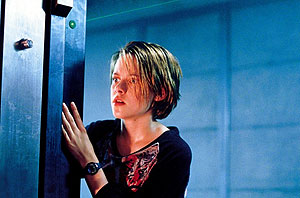 his conscience, having only agreed to the heist so he can give his own child a better life than he had. As adults that’s what we’d all wish for our children and Panic Room can be seen as a film about protecting innocence, but it also carries the message that while technology can be impressive it can’t always keep us safe. Although not necessarily a post-9/11 film as it was in production prior to the September 11th attacks, the theme of personal safety is an important theme and one that Wheeler W. Dixon picks up on.
his conscience, having only agreed to the heist so he can give his own child a better life than he had. As adults that’s what we’d all wish for our children and Panic Room can be seen as a film about protecting innocence, but it also carries the message that while technology can be impressive it can’t always keep us safe. Although not necessarily a post-9/11 film as it was in production prior to the September 11th attacks, the theme of personal safety is an important theme and one that Wheeler W. Dixon picks up on.
Yet Foster wasn’t so enthusiastic about panic rooms and said during one interview:
- [1] Wheeler Winston Dixon, Film and Television After 9/11 (2004), Southern Illinois University Press
- [2] John Hiscock, Jodie Finds The Key To Contentment, The Telegraph, April 29th, 2002
Despite having all the security terrible things still happened, both in Meg and Sarah’s house and in America on September 11th. The film leaves us to ponder the thought that it’s only through human ingenuity, compassion and bravery that we’ll ever be truly safe, rather than through state-of-the-art panic rooms, surveillance and communication systems.
Panic Room remains one of my all-time favourite films because of these complex themes, performances and because of Fincher’s direction. It’s also one of the films I rarely re-watch because it’s so effective in the way it heightens and releases the tension throughout, giving a sense of panic that’s almost too palpable and utterly inescapable for those who are sensitive to these situations.
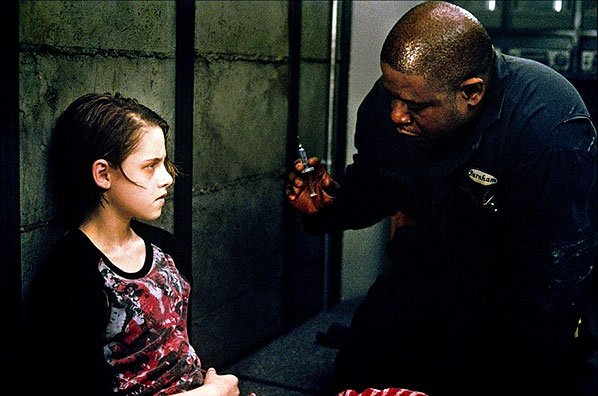

Patrick Samuel
The founder of Static Mass Emporium and one of its Editors in Chief is an emerging artist with a philosophy degree, working primarily with pastels and graphite pencils, but he also enjoys experimenting with water colours, acrylics, glass and oil paints.
Being on the autistic spectrum with Asperger’s Syndrome, he is stimulated by bold, contrasting colours, intricate details, multiple textures, and varying shades of light and dark. Patrick's work extends to sound and video, and when not drawing or painting, he can be found working on projects he shares online with his followers.
Patrick returned to drawing and painting after a prolonged break in December 2016 as part of his daily art therapy, and is now making the transition to being a full-time artist. As a spokesperson for autism awareness, he also gives talks and presentations on the benefits of creative therapy.
Static Mass is where he lives his passion for film and writing about it. A fan of film classics, documentaries and science fiction, Patrick prefers films with an impeccable way of storytelling that reflect on the human condition.
© 2022 STATIC MASS EMPORIUM . All Rights Reserved. Powered by METATEMPUS | creative.timeless.personal. | DISCLAIMER, TERMS & CONDITIONS
HOME | ABOUT | CONTACT | TWITTER | GOOGLE+ | FACEBOOK | TUMBLR | YOUTUBE | RSS FEED
CINEMA REVIEWS | BLU-RAY & DVD | THE EMPORIUM | DOCUMENTARIES | WORLD CINEMA | CULT MOVIES | INDIAN CINEMA | EARLY CINEMA
MOVIE CLASSICS | DECONSTRUCTING CINEMA | SOUNDTRACKS | INTERVIEWS | THE DIRECTOR’S CHAIR | JAPANESE CINEMA





